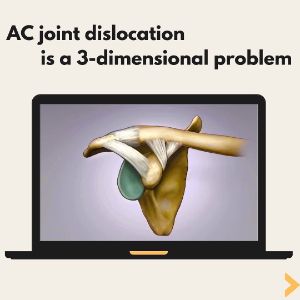New research from a large multi-center study in France confirms that while double endobutton fixation is an important component of clinical success for an AC Joint Separation, better results can be achieved by augmenting the repair with both AC capsule repair as well as using biologic tissue to ensure long term success. This confirms the findings by Steven Struhl, MD in his recently published long-term clinical study “Continuous Loop Double Endobutton Reconstruction for Acromioclaviculaar Joint Dislocation” in the prestigious orthopedic journal, American Journal of Sports Medicine.
While double button fixation represents a significant improvement from classic techniques involving pins and screws, numerous studies have shown high rates of failure and complications when it is used as a stand-alone fixation. While the double button devices provide very strong fixation in the vertical plane, they do not control for pathologic movement in the horizontal plane and this results in early failure and complications. In Dr. Struhl’s study, uniformly excellent long-term clinical results were achieved in 35 patients with only one patient who had fixation failure. In this study the closed loop double endobutton device was augmented with additional mechanical fixation to control horizontal movement (the “trapezoid” suture) as well as imbrication (tightening) of the AC ligaments themselves resulting in a strong construct that resisted forces in multiple planes that is necessary to account for the complex movement of the scapula with normal activities of daily living. In addition Dr. Struhl added either a primary ligament repair or a tissue graft to the construct to ensure permanent stability.
The study by Dr. Barth and sponsored by the French Society of Arthroscopy examined the question of whether fixation with a double button device alone was sufficient to achieve excellent reproducible results. With over 100 patients included in this multi-center study they used simple fixation in half of the patients and comprehensive fixation in the other and then compared the groups both in terms of x-ray as well as clinical results. Their results were conclusive. “This study demonstrates that acute AC joint dislocation requires stabilization in both planes. Coracoclavicular stabilization alone is not sufficient, regardless of the type of implant used. Implantation of a biologic graft should be considered when the time from injury to surgery is longer than 10 days”.
In addition they also found that the more accurate the reduction of the joint the better the results. This clearly contradicts previous studies have implied that some loss of fixation would not affect clinical results. “A major finding from our study is that the anatomical outcome correlates with the functional outcome”. With regard to the problem of slippage in using double button devices Dr. Barth stated, “Loss of reduction after treatment with a double endobutton alone may be ascribable to insufficient strength of the implant and absence of acromioclavicular stabilization”. Also, they found that results from surgery were significantly better in patients who underwent immediate surgery after the injury rather than delaying. They stated, “Surgery should undoubtedly be performed at the early inflammatory phase, before cell repair mechanisms become active, to increase the likelihood of spontaneous ligament healing.”
In summary, the French study confirms many of the same findings in Dr. Steven Struhl’s study; the importance of multiaxial fixation, primary repair/reconstruction of the AC joint capsule, use of biologic tissue in all cases, and early intervention to ensure long term success of an AC Joint Separation surgery.
Posted on behalf of Steven Struhl MD




